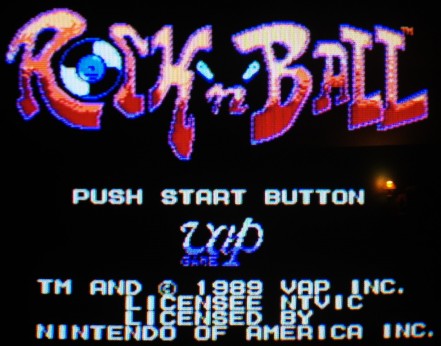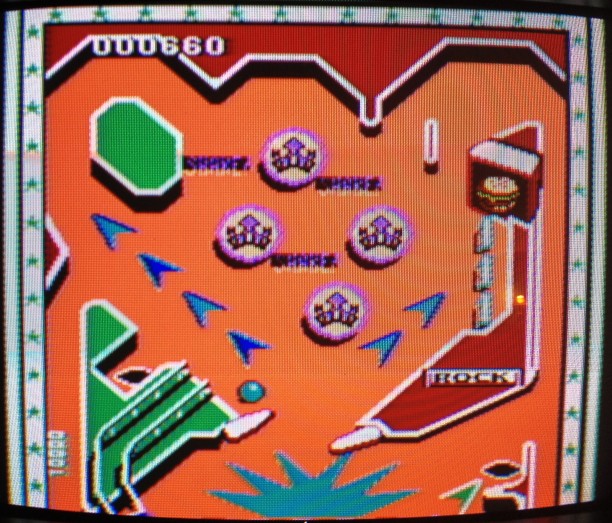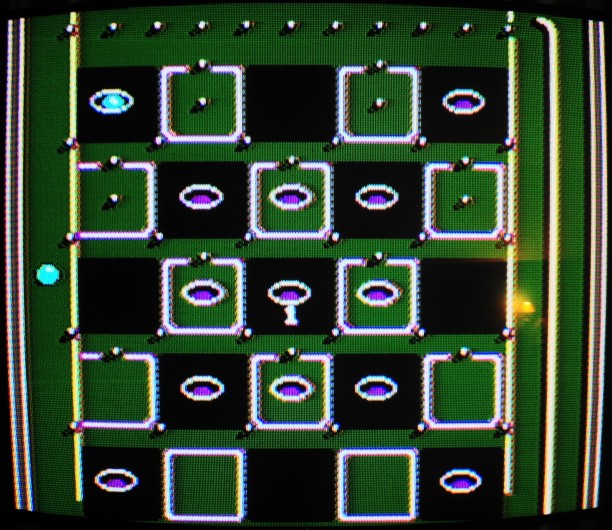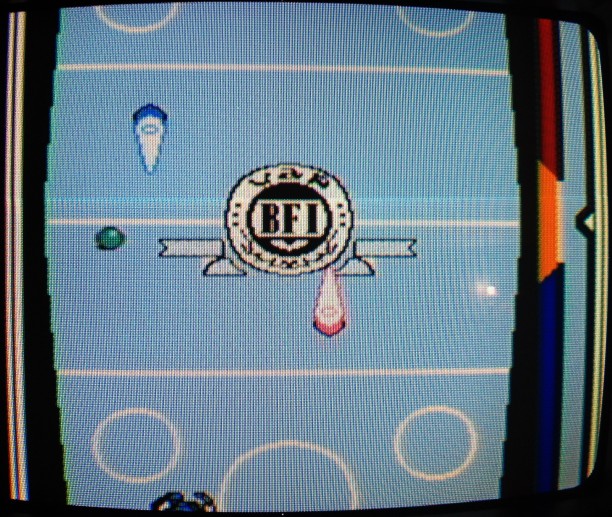
Pinball Alley
Pinball Alley: Rock N Ball
Up to now, I’ve covered the best traditional pinball games that the NES has to offer. The columns have been long and have been splits between reviews and gameplay strategy. The last two pinball games left on the slate– Pinball Quest and Rock ‘n Ball— aren’t really traditional pinball simulations at all. It’s difficult to really break them down as I have the prior games, and especially in the case of this column for Rock ‘n Ball, there really isn’t a lot of strategy to impart. Nevertheless, Rock ‘n Ball does utilize pinball as a central theme… so I’ll take a stab at talking about it.
Including traditional Pinball, Rock ‘n Ball has four gameplay modes. The other three are a strange Pachinko hybrid called 9-Ball, a Battle mode that plays like a cross between pinball and Foosball, and a Sports mode that uses ice hockey or soccer themes and is similar to Battle mode. Surprisingly, the Sports mode is the one that I have the most fun playing here instead of the traditional pinball game… but I’ll cover the Sports games last.
The Pinball mode is an original table that is pretty light on features. The playfield is split into two levels. When the ball is launched into play, the upper level has four large bumpers that make a diamond-type shape in the center of the playfield. There is a loop in the upper left, which directs the ball back into the bumper array and gives the player no points for the effort. There is a bank of drop targets to the right, with a varying bonus item that can be collected if the player can drop all three targets. Hitting these targets requires a “back door” shot with the right flipper, which requires the player to hold the ball on the flipper until it rolls back to the hinge and then hit the flipper early to send the ball up and to the right. This shot takes some practice, and is made more difficult by the haphazard ball physics on display in Rock ‘n Ball, but most players can learn it within a couple of games. One other notable on the upper level is the 10,000 point rollover on the far left that sends the ball down to the lower level. Players really don’t have control over getting the ball to hit this rollover, but it’s not a bad way to score some quick points if the ball happens to go this way.

Here’s the upper level of the Rock ‘n Ball playfield. Note the drop targets and the hamburger bonus on the right.
The lower level has items of interest such as a ramp shot to carry the ball back up to the upper level, a couple of capture holes that raise ball savers over the left and right outlanes, a set of three rollover lanes in the center of the playfield, and a couple of drop targets on the far right. As with the other multi-level playfields that I’ve covered in earlier columns, the best strategy here is to aim for the ramp and get the ball back to the upper level. Keeping the ball on the lower level for extended periods of time is courting the possible end of your turn with an errant shot or bad bounce.
There really isn’t much to work with on the traditional pinball table in Rock ‘n Ball. It’s even more rudimentary than what we saw in Nintendo’s own Pinball, and that game is older. There aren’t any bells and whistles here like multiball or bonus multipliers. It’s actually the worst table that I’ve covered in this column so far. There is a leaderboard to shoot for, should you decide to for more than 500,000 points and the top spot. I’m not sure if I could do it or not, but I honestly couldn’t maintain interest long enough to try.
9-Ball is a gambling game that plays a lot like Pachinko. Players place their bets and then try to get balls locked in designated capture holes to create patterns and win money. Unlike Pachinko, however, there is a set of flippers at the bottom of the board. Players can use the flippers to shoot the ball back into play and possibly aim for the capture holes if they were missed post-launch. Players can also nudge the board and help to push the ball away from outlanes or towards a specific target. Nudging is a critical skill for 9-Ball, but it’s worth noting that the desired result isn’t always the final result when doing so. Overall, 9-Ball is a diversion at best and most players will lose interest after a couple of rounds. It’s an interesting idea but really doesn’t stand out.
Battle mode is a bit like Foosball or table hockey. The objective is to send the ball past the other player’s flippers and down his or her drain to score a point. Unlike Foosball though, each player has only a pair of flippers that can be used. The flippers can be adjusted between a defensive position (near the drain) or into an offensive position (by pressing up on the D-pad and moving the flippers onto the opponent’s side of the playfield). Each of the three different Battle tables– Bomb, Thunder, and Attack– has its own set of shots to aim for to gain an advantage and thus plays a bit like pinball in that respect. Drop and impact targets, when hit, can raise ball savers or affect the ball in play. It’s a good idea to play games on each table before taking on a human opponent in order to learn the layout and how each shot or target will affect play. The matches move at a pretty good pace, whether players compete against human or computer-controlled players, as each match ends when three points are scored by either side. Ultimately winning the game requires a certain number of matches won in a best of 3, best of 5, or best of 7 format. Battle games are pretty fun, although computer-controlled opponents sometimes do some pretty dumb things.
Sports mode games have the same basic objective as Battle mode games do, although flippers are replaced with goaltenders and there’s only one vertical flipper per side. This makes the Sports mode feel a bit more like Foosball. Eliminating the pinball aspects and focusing more on the basics of scoring goals makes these games a lot more straightforward and thus easier for players of any skill level to jump right in and play. I tend to prefer the Ice Hockey games, as a hockey fan, but there really isn’t much of a difference between Hockey and Soccer in the Sports mode except for ice instead of pitch. Players will probably need a few matches of experience to get the hang of using the vertical flippers. It definitely requires a different approach after playing games with horizontal flippers; new timing must be learned, and it’s not necessarily intuitive. Still, once you get the hang of it, the Sports games are the hidden gems on an otherwise underwhelming package.
Rock ‘n Ball isn’t a game that I can really recommend for your collection as a pinball experience. The ball physics are inconsistent, the pinball table offered here is generally uninteresting and not very engaging, and the extra gameplay modes are hit-and-miss. The visuals are pretty simplistic, and the sound and music are poor. It is worth noting, however, that Rock ‘n Ball is the most uncommon NES pinball game. NintendoAge ranks it a 5 out of 10 on its rarity scale, which is the highest of the pinball games for the platform. (Rollerball is the closest with a 4.) If you see it in the wild and you’re a collector, it may still be worth getting. The Sports mode is also worth putting the cartridge into your NES and playing a few games every now and then, if you have the game.
Five NES pinball games down, one to go. That’s right: Pinball Quest is coming in two weeks’ time. Did I save the best for last? I’ll let you know then.

